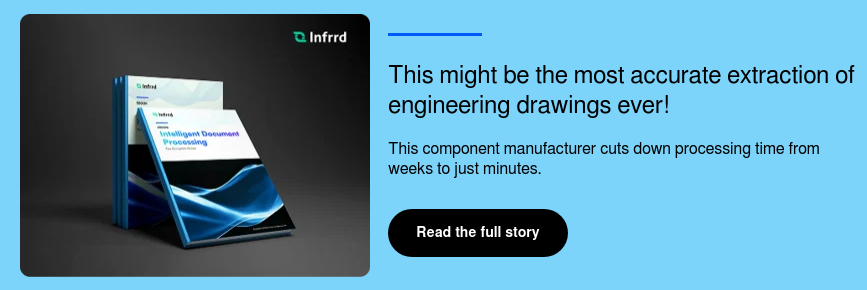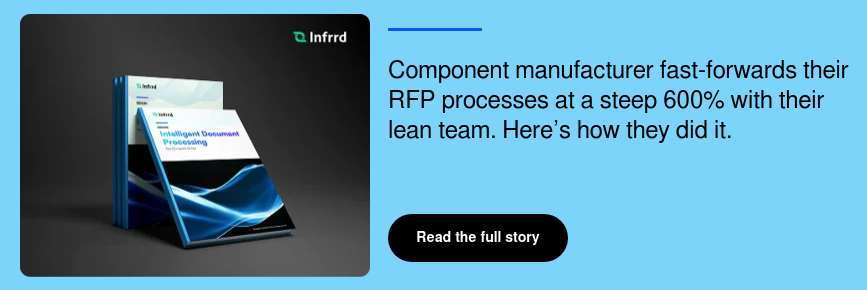We’re living in the age of AI, where technology is transforming tasks once done manually into streamlined, efficient processes. While Artificial Intelligence (AI) is taking over, industries like construction and manufacturing are still catching up, where data extraction from engineering diagrams is often done manually or with the help of traditional tools, leading to errors, inefficiency, and frustration. But let’s admit it: the old ways just aren’t cutting it anymore.
Did you know? “Construction is one of the least automated industries where over 90% of the information used in the construction field is in the paper format.”
Think OCR is the Best AI for Engineering Drawings? You're Wrong
Traditional tools like basic OCR (Optical Character Recognition) are not the most up-to-date when it comes to image data extraction especially for complex images like engineering drawings. OCR primarily relies on value pair detection, which limits its effectiveness to structured documents. While it can handle simple text extraction, OCR struggles with the complexities of technical drawings—such as intricate symbols, diverse formats, and non-standard elements. Its lack of contextual understanding often leads to misinterpreted or incomplete data, making it unsuitable for the nuanced demands of engineering diagrams. In essence, OCR falls short when it comes to handling the complexity and variability found in modern engineering designs.
As projects grow and the volume of engineering drawings increases, traditional methods and tools can struggle to keep up. Scaling manual processes or traditional tools to handle large volumes of engineering data effectively is challenging and often requires substantial resources and time.
Traditional tools may not be easily adaptable to evolving standards or new types of engineering drawings. As technology and practices change, these tools might require updates or replacements to stay relevant, leading to additional costs and disruptions.
Time is Money!(especially for technical drawings)
Manufacturers and construction companies often manage thousands of engineering drawings, each containing crucial information for various teams—R&D, production, quality assurance, design, maintenance, inventory, and sales. Cost efficiency in every process depends on how quickly and accurately engineers across teams can access and use this data.
“On average, data extraction and accuracy checks take up to $4.8 billion in labor costs. Once the data is in hand, operations and maintenance engineers invest another $613 million just to reformat it into something usable for staff.”
So, the next time you notice delays in your processes, remember—it’s not just about lost time; it’s also about lost money. That’s why automation is essential, not just for speeding up and improving data accuracy but also for keeping your budget in check.
But here’s the catch: simply picking any AI tool won’t solve the problem. Choosing the wrong one can be just as bad as relying on manual labor—only now, you’re adding the cost of AI implementation on top. With delays already piling up, do you really want to make things more chaotic?
So, while AI has come a long way, the real key to cutting costs and boosting efficiency is integrating the right tools into your workflows. It’s not just about choosing an AI that looks impressive on the surface—you need one that truly fits your needs. Don’t unknowingly rely on the wrong tools and miss out on the benefits AI can bring.
AI for Engineering Drawing : Are We There Yet?
AI-driven image detection, powered by deep learning and Convolutional Neural Networks (CNNs), is great at spotting patterns and pulling out useful data from images. These technologies handle huge amounts of visual data with impressive accuracy. However, matching or exceeding an engineer's understanding, whether it is a hand drawn diagram or AutoCAD is challenging. Because engineering drawings are full of non-standard symbols and mixed data types (like text, symbols, and lines), is still tough. Why?
Humans excel at understanding complex diagrams because we can grasp not just individual symbols and details but how they all fit together in context. Our ability to interpret these images is shaped by years of experience and intuitive reasoning. We naturally see the bigger picture and understand how different elements relate to each other and to external factors.
In contrast, older technology often falls short in this area. It struggles with low-resolution or poor-quality images, which can muddle data extraction. Additionally, problems like overlapping elements or inconsistent formatting can lead to mistakes, making it difficult to piece together the full story accurately. It’s a bit like trying to decipher a messy, incomplete map—you might get some of the way, but it’s easy to miss important details. So, what’s next?
Don’t Settle for Less - Go for the Best with AI!
We’re in the era of AI hype and hyper-automation, but not everyone distinguishes between outdated tech and cutting-edge AI. Advanced AI goes beyond just data extraction and automation; it offers a deeper, more accurate understanding of data, showing how each piece fits into the bigger picture of engineering drawings. It’s like having a high-tech guide that not only reads the map but also reveals how every detail connects and matters.
ML-AI-Led-IDP for the Rescue!
Unlike basic OCR or standalone image recognition tools, AI-native Intelligent Document Processing (IDP) systems combine multiple technologies to understand the context of the entire document. They leverage Machine Learning models that continuously learn and adapt, improving their accuracy over time. IDP platforms, particularly through Deep Learning, can not only read and extract relevant data but also learn from previous mistakes. This added feature helps them understand the relative elements, nuances, and complexity of engineering diagrams with great accuracy and speed. This is what you aim for when you’re looking out for the smartest AI.
Infrrd’s AI-Powered IDP for Image Detection for Engineering Drawing
At Infrrd, our team is committed to exploring AI-native technologies and their potential applications. Together, we designed and IDP exclusively for engineering drawings, that combines the speed and accuracy of machines with the nuanced comprehension of humans. Therefore Infrrd’s IDP for Engineering Drawings can read, understand, analyze, and process complex images or any part of the diagram without any breaks. It can learn from its own mistakes and apply the same algorithm to every image resulting in consistent results, faster processing, and higher accuracy.
“We want the smartest AI to handle the complexities of data extraction while you work on what matters most.” - Team Infrrd
Infrrd’s Powerful AI-Powered IDP Platform can Automate all Types of Technical Drawings-
- Circuit Diagram
- Wiring Diagrams
- Block Diagrams
- Schematic Diagrams
- P&ID Diagrams
- Assembly Diagrams
- Process Flow Diagrams
- Equipment Layout Diagrams
- Control System Diagrams
- Construction Building Images
- Any Type of Component Manufacturing Drawing
Guaranteed Results You Can Trust with Infrrd’s AI-Led IDP for any Type of Engineering Drawings
> Accurate Data Readings, Every Single Time
Our AI-powered No-Touch Processing offering ensures that data extracted from technical designs are up to 100% accurate every single time.
> Hyper-Fast Data Extractions
Infrrd’s IDP guarantees improvement in engineering drawing/design data processing time up to 95%! This means tasks that once took hours can now be completed in minutes, significantly boosting efficiency and freeing up valuable resources for other critical operations.
> Less Scraps, More Cost Savings
High-accuracy data from technical design drawings avoids costly rework, scrap, and delays in production. Reduced human errors ensure effective resource and material utilization.
> Effective Maintenance
Accurate data extraction from engineering designs lead to precise maintenance predictions and fewer failures.
> Faster RFQ Submissions
Comprehensive data extracted from quotation requests help contractors create more competitive bids that better reflect the project’s requirements and market rates within hours. With reduced time spent on each quote, they maximize the volume of bids submitted, especially on the field, by sharing instant estimations of on-the-go sales to win more bids.
> Small Team, Big Money!
Our IDP lets you handle high RFQ volumes faster with the same lean team you have today. This helps you keep your budgets in control while aiming for bigger business returns. It’s a win-win!
FAQs
Using AI for pre-fund QC audits offers the advantage of quickly verifying that loans meet all regulatory and internal guidelines without any errors. AI enhances accuracy, reduces the risk of errors or fraud, reduces the audit time by half, and streamlines the review process, ensuring compliance before disbursing funds.
Choose software that offers advanced automation technology for efficient audits, strong compliance features, customizable audit trails, and real-time reporting. Ensure it integrates well with your existing systems and offers scalability, reliable customer support, and positive user reviews.
Audit Quality Control (QC) is crucial for mortgage companies to ensure regulatory compliance, reduce risks, and maintain investor confidence. It helps identify and correct errors, fraud, or discrepancies, preventing legal issues and defaults. QC also boosts operational efficiency by uncovering inefficiencies and enhancing overall loan quality.
Mortgage review/audit QC software is a collective term for tools designed to automate and streamline the process of evaluating loans. It helps financial institutions assess the quality, compliance, and risk of loans by analyzing loan data, documents, and borrower information. This software ensures that loans meet regulatory standards, reduces the risk of errors, and speeds up the review process, making it more efficient and accurate.
Yes, AI can identify and extract changes in revised engineering drawings, tracking modifications to ensure accurate updates across all documentation.
Yes, advanced AI tools can recognize and extract handwritten annotations from engineering drawings, capturing important notes and revisions for further processing.












